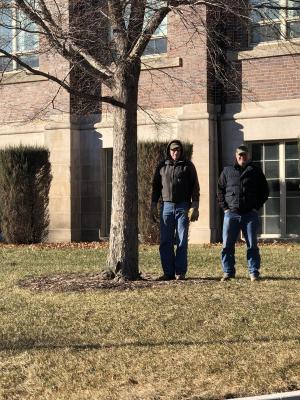Emerald Ash Borer Trees
Emerald Ash Borer (EAB) Update: 1-14-19
Out of the Ashes, we will rise.
In a letter from President J. W. Maucker, Iowa State Teachers College, to Mr. E. E. Cole, Director of the Physical Plant, ISTC November 1957. President Maucker said “I am enclosing the announcement from the Waterloo Chamber of Commerce concerning the meeting on Dutch Elm Disease.”
In a letter from President J. W. Maucker, Iowa State Teachers College, to Mr. E. E. Cole, Director of the Physical Plant, ISTC November 1957. President Maucker said “I am enclosing the announcement from the Waterloo Chamber of Commerce concerning the meeting on Dutch Elm Disease.”
Sixty years ago this campus begin to deal with the Dutch Elm Disease (DED). After a valiant effort lasting approximately ten years the majestic American Elm fell to its nemesis DED. In the late 1960’s and early 1970’s the ISTC Ground staff was responsible for the removal of over four hundred American Elm trees from our campus. Many varieties of trees were planted, but the Ash tree was an inexpensive and fast growing tree and was used as a replacement tree for the Elm on campus and our cities in North America.
Emerald Ash Borer (EAB) was introduced to the United States in Detroit Michigan in 2002. It is believed that it made its way here from China inside a cargo ship in a wooden pallet.
When UNI Facilities Management and the UNI Grounds staff heard about the EAB and its potential effects it would have on our campus, we adopted a proactive plan.
Our plan was/is to use as many means available to us to fight the pest much like they did the DED back in the 1960’s. With history on our side we first saw the need to start planting immediately to limit the “scorched earth” look on campus. Since 2003 we have planted on average 110 shade, understory and evergreen trees per year.
Another component of the plan was to sacrifice some Ash to the EAB and try to protect some significant Ash trees from the EAB. Using 23rd St. on the north, College St. to the east, University Ave. to the south, and Hudson Rd. on the west as borders we would treat the Ash trees inside these borders. Outside these borders would be considered no treatment. Information at the time was to begin treating trees for the EAB when you have a confirmed sighting within 15 miles. In 2014 the EAB was found in Waterloo approximately 15 miles from campus. In 2015 we begin treatment. 2016 we confirmed EAB on campus south of University Ave. The fall of 2018 we started to remove some of the infected ash south of University Ave. and west of Hudson rd.
In the aftermath of the DED the industry begin to propagate native Elm with some of the surviving American Elm. Their efforts were very successful and today we have many new Elm cultivars. I am confident that the industry will have new ash cultivars in the future for use in the landscape.
We have come full circle, we lost the Elms and planted Ash. We are losing the Ash and we are planting many varieties of trees some of which are new Elm cultivars! I encourage you to enjoy this full circle tree story as you direct your steps to the east side of the ITTC building where you will find three Elm trees planted by the UNI Grounds staff in 2006 as part of our Ash tree replacement plan.
So, when life kicks you in the Ash, and you think you lost your spot in the shade, rest assured, there will always be a shaded spot for you to sit down and rest your weary Ash.


The two pictures above show the growth of an Elm tree that was planted outside of the Innovative Teaching & Technology Center in 2006. The first picture was taken just after the tree was planted in 2006 and the second picture was taken January 2019.

The picture above shows a portion of an Ash tree removed from campus showing signs of Emerald Ash Borer (EAP) damage. You can see a larva that crawled out from the stump as well as the tunnels that EAB larva create in the bark.
